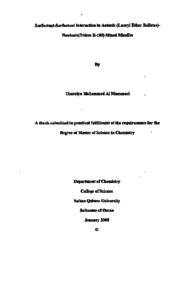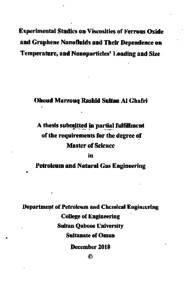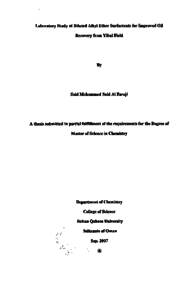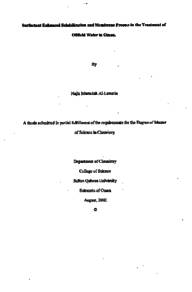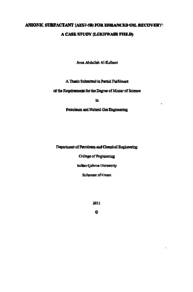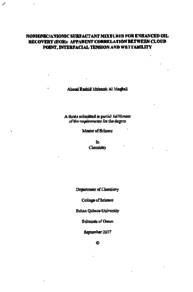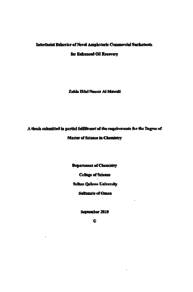Document
Surfactant-surfactant interaction in anionic (Lauryl ether sulfates)-nonionic (Triton X-100) mixed micelles
Publisher
Sultan Qaboos University
Gregorian
2008
Language
English
Subject
English abstract
This study investigates the surfactant-surfactant interaction in anionicnonionic mixed micelles. Surfactants selected in this work consist of anionic sodium dodecyl sulfate (SDS); a CS series of lauryl ether sulfates (C$130, CS230, CS330) having different degree of ethoxylation, and a toctylphenoxypolyethoxyethanol (Triton X-100). The critical micelle concentrations in single surfactant systems were determined by surface tension, conductivity and fluorescence measurements and were found to be 0.8 mm, 8.3 mM and 0.22 mM for CS series, SDS and Triton X-100 respectively. The values obtained by the three different measurements are in close agreement and were close to the reported ones in the literature. The lower CMC of the lauryl ether sulfates compared to SDS was associated to the intramolecular ion-dipole interaction in lauryl ether sulfate surfactants. The CMCs of CS series were found to be similar, indicating that only the introduction of one ethylene oxide (EO) group is responsible for the substantial decrease in the CMC from 8.3 mM (SDS) to 0.8 mM (C$130). Interestingly, the ionization degree Bion (0.75 F 0.05) in lauryl ether sulfates were similar and higher that the degree of ionization in SDS micelles (0.35 F 0.03), suggesting that the charge density in SO4 (in CS series) is higher than the charge density in SDS sulfate group.
Surfactant-surfactant interaction was investigated in ethoxylated /TX-100 mixed micelles system (CS130/TX-100, CS230/TX-100, and CS230/TX-100) and in nonethoxylated sulfate/Triton X-100 (SDS/TX-100) as well in order to compare the relative strengths of interaction between those two systems. In all surfactant mixtures CS-series/TX-100 and SDS/TX-100, the experimental CMCs were lower than the ideal ones. This negative deviation from ideality is reflecting synergism. Surfactant-surfactant interaction parameters in mixed micelles su were derived according to Rubing's theory. The higher BM value (- 3.7) in SDS/TX-100 system indicates a strong interaction between SDS and TX-100, whereas relatively weaker interaction was found between CS series and TX-100 as reflected by the relatively lower BM value (-1.38) found in these systems. This was attributed to the intramolecular ion-dipole interaction in ethoxylated sulfated surfactants both in single surfactant micelles as well as in CS/TX-100 mixed micelles.
Member of
Resource URL
Arabic abstract
ركزت هذه الدراسة على التأثير المتبادل بين خليط من المنشطات السطحية الأيونية والغير أيونية. المنشطات السطحية المستخدمة في هذه الدراسة عبارة عن منشطات أيونية (SDS) و منشطات غير أيونية (100-TX) ومنشطات غير أيونية معدلة وهي سلسلة من مجموعة الألكيل ايثر سولفات ( ,CS130CS230 , CS330 ) .بداية تم تحديد التركيز الحرج للمنشطات السطحية المستخدمة بثلاث طرق: التوتر السطحي والتوصيل الكهربائي والإستشعاع (التفلور)، حيث وجد أن التركيز الحرج لهذه المنشطات السطحية (8 . 3 ملي مولاري 0 . 22 ملي مولاري، 0. 8 ملي مولاري) لTX - 100 ،SDS CS130 , CS230 , CS330على التوالي وهذه النتائج تتفق مع تلك الموجودة في المراجع. كما وجد أن التركيز الحرج ل سلسلة مجموعة الألكيل ايثر سولفات أقل من SDS ويعزى ذلك إلى زيادة الخاصية الكارهة للماء في مجموعة الألكيل ايثر سولفات.
إضافة إلى ذلك تم التوصل إلى أن التركيز الحرج لمجموعة الألكيل سولفات لا يعتمد على عدد وحدات الإيثيلين أوكسيد الموجودة والدليل على ذلك أن نفس قيمة التركيز الحرج تم الحصول عليها لهذه السلسلة من المنشطات السطحية. كذلك وجد أن درجة التحلل (الذائبية لمجموعة الألكيل سولفات أعلى منهالSDS والسبب في ذلك هو نقص كثافة شحنة ال SO4 في حالة SDS عنها لمجموعة الألكيل سولفات.
في هذه الدراسة أيضا تم استخدام نوعين من المنشطات السطحية: مجموعة تحتوي على إيثيلين أكسيد وهي مجموعة الألكيل سولفات المذكورة سابقا ومجموعة لا تحتوي على إيثيلين أكسيد وهي SDS وتم خلطها مع 100-Triton X بنسب متفاوتة من أجل مقارنة القوة المتبادلة بين كل نوعين من المنشطات السطحية في كل خليط. وقد وجد أن معامل التأثير المتبادل في حالة( 100- SDS/ TX ) تساوي (-3 . 7) وهي قيمة عالية تعكس قوة الإرتباط بين كلا النوعين من المنشطات السطحية، بينما كانت القيمة (- .39) في حالة (100-
1CS130 , CS230 , CS330 / TX) مما يدل على أن الارتباط ضعیف. نقص قيمة المعامل في الحالة الثانية يعزى إلى وجود قوة التأثير الحثي الداخلي في مجموعة مجموعة الألكيل سولفات والتي أدت إلى إضعاف قوة الارتباط بين كلا النوعين من المنشطات السطحيةفي جميع خلطات المنشطات السطحية (100-CS130 / TX - 100 , CS230 / TX - 100 , CS330 / TX) وكذلك ( 100- SDS / TX ) كانت التراكيز المخبرية أقل من تلك المحسوبة نظريا وذلك عائد إلى التفاعل الجزيئي بين تلك المنشطات.
إضافة إلى ذلك تم التوصل إلى أن التركيز الحرج لمجموعة الألكيل سولفات لا يعتمد على عدد وحدات الإيثيلين أوكسيد الموجودة والدليل على ذلك أن نفس قيمة التركيز الحرج تم الحصول عليها لهذه السلسلة من المنشطات السطحية. كذلك وجد أن درجة التحلل (الذائبية لمجموعة الألكيل سولفات أعلى منهالSDS والسبب في ذلك هو نقص كثافة شحنة ال SO4 في حالة SDS عنها لمجموعة الألكيل سولفات.
في هذه الدراسة أيضا تم استخدام نوعين من المنشطات السطحية: مجموعة تحتوي على إيثيلين أكسيد وهي مجموعة الألكيل سولفات المذكورة سابقا ومجموعة لا تحتوي على إيثيلين أكسيد وهي SDS وتم خلطها مع 100-Triton X بنسب متفاوتة من أجل مقارنة القوة المتبادلة بين كل نوعين من المنشطات السطحية في كل خليط. وقد وجد أن معامل التأثير المتبادل في حالة( 100- SDS/ TX ) تساوي (-3 . 7) وهي قيمة عالية تعكس قوة الإرتباط بين كلا النوعين من المنشطات السطحية، بينما كانت القيمة (- .39) في حالة (100-
1CS130 , CS230 , CS330 / TX) مما يدل على أن الارتباط ضعیف. نقص قيمة المعامل في الحالة الثانية يعزى إلى وجود قوة التأثير الحثي الداخلي في مجموعة مجموعة الألكيل سولفات والتي أدت إلى إضعاف قوة الارتباط بين كلا النوعين من المنشطات السطحيةفي جميع خلطات المنشطات السطحية (100-CS130 / TX - 100 , CS230 / TX - 100 , CS330 / TX) وكذلك ( 100- SDS / TX ) كانت التراكيز المخبرية أقل من تلك المحسوبة نظريا وذلك عائد إلى التفاعل الجزيئي بين تلك المنشطات.
Category
Theses and Dissertations

